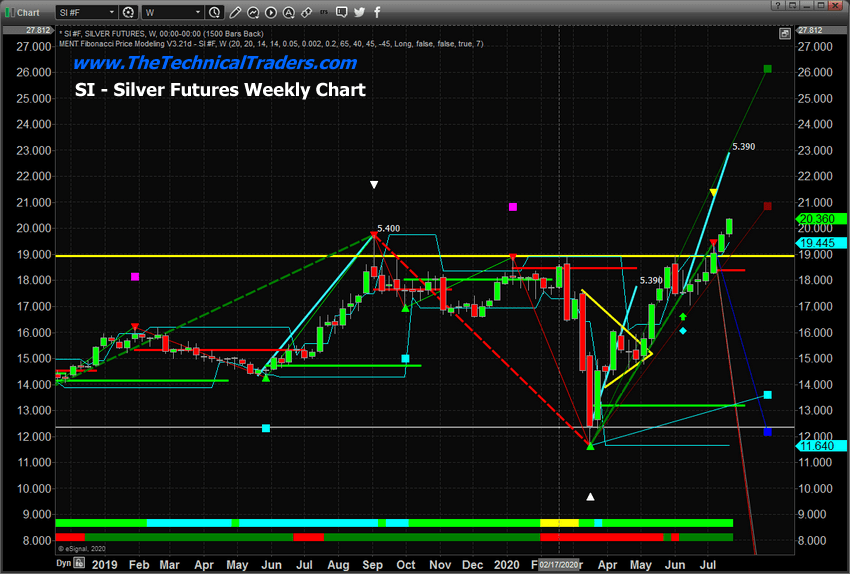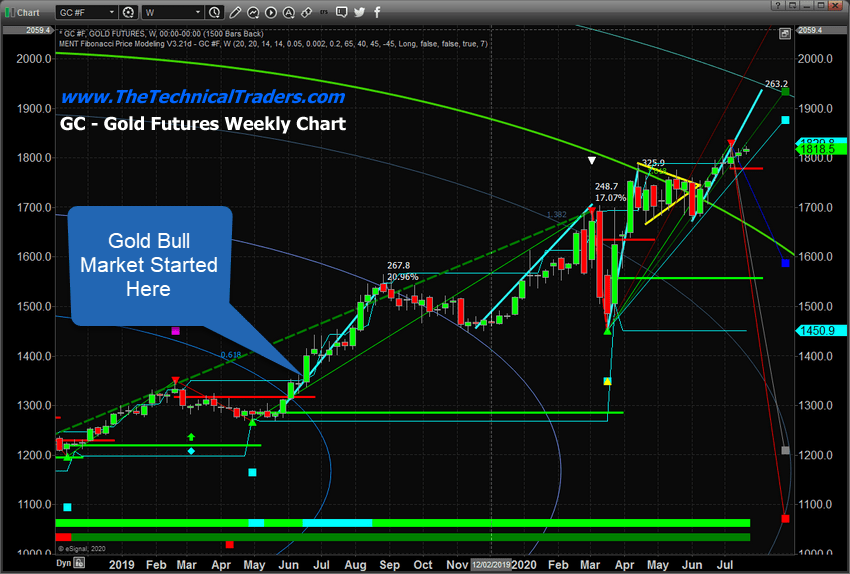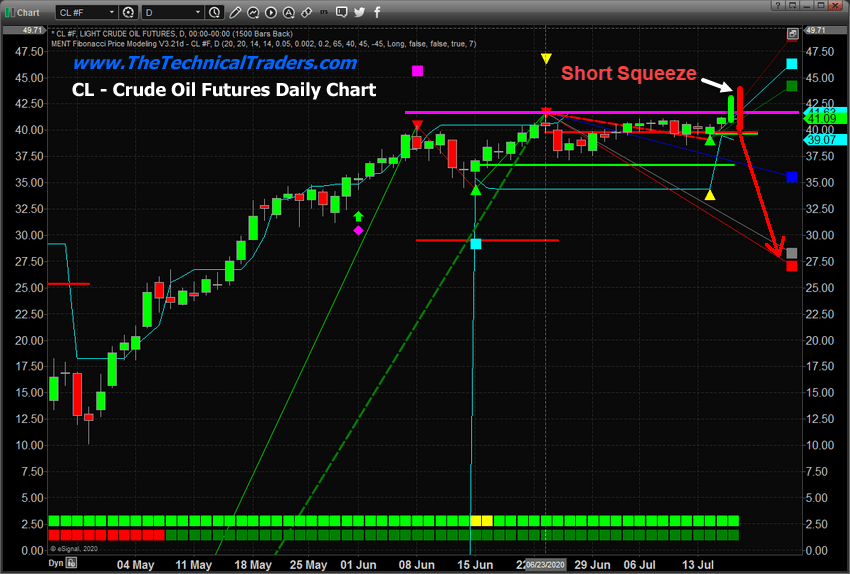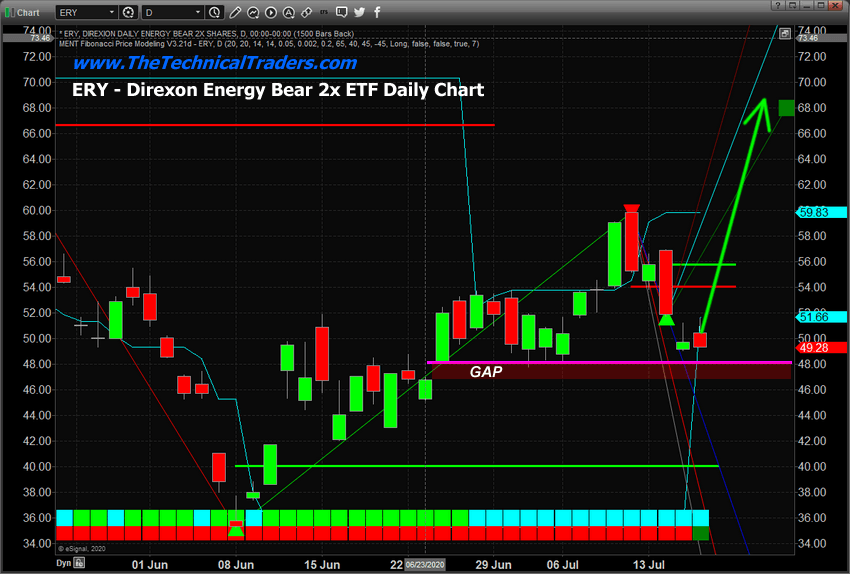InvestMacro
Author Archive for InvestMacro – Page 8
While the scandal served as catalyst for the fire, the match was lit a long time ago
By Elliott Wave International
“Catastrophic Failure” — June 18 CCN
“Swift, Spectacular Implosion” — June 25 Alijazeera.com
“Doomsday” — June 18 Seeking Alpha
These are a few descriptions for Munich-based Fintech firm Wirecard, whose recent epic fall from grace is one of the biggest financial bombshells in Germany’s history. This chart captures the stock’s crater-making crash in June — from 104 euros per share, to ONE single euro.

10 out of 10 mainstream experts say the catalyst for Wirecard’s crash was the June 19 revelation that nearly $2 billion in supposed profits had mysteriously vanished from the company’s balance sheet. (If it was ever there to begin with). Dubbed the “Enron of Germany” by a June 29 CNBC article, Wirecard’s scandal led to the firing of its CEO, a bankruptcy filing, and a $4 billion IOU-zilla issuance to creditors.
Surmised the June 25 Reuters:
“The collapse of Wirecard, once one of the hottest fintech companies in Europe, dwarfs other German corporate failures. It has shaken the country’s financial establishment … A scandal like Wirecard is a wake-up call that we need more monitoring and oversight than we have today.”
True, except there has already been more than one “wake-up call” — as early as two years ago.
Back on January 23 — of 2018 — one news source revealed how Wirecard was well-known for “making highly unusual purchases,” using “adjusted metrics to inflate the appearance of earnings,” and skirting a 7-month long investigation into a deal that saw 175-285 million euros missing from the company’s coffers, leaving the sellers unpaid.
Yet, as that same article observed, these dubious episodes didn’t stop investors from “still placing their faith — and money — behind Wirecard.”
The ultimate show of that faith came in August 2018 when the green startup from a tiny Bavarian town known for beer gardens and bird-watching unseated Germany’s second-largest bank, 150-year old Commerzbank, from Germany’s venerable DAX stock market index.
And then came the latest Wirecard scandal, which supposedly “caused an 80% plunge in the company’s stock price over the last two days.” (New York Times, June 19)
All of which begs the question: Why did investors, after backing up Wirecard’s dubious practices for years, suddenly lose faith in the company?
And was there a way to foresee that change of heart?
Our friends at Elliott Wave International believe the answer is yes — and it comes down to investor psychology, or social mood.
Wrote Elliott Wave International’s President Bob Prechter in his New York Times best-selling book Conquer the Crash:
“When the social mood trend changes from optimism to pessimism, creditors, debtors, producers and consumers change their primary orientation from expansion to conservation.”
“Conservation” for investors manifests as doubt in the worth of a stock. Adds Prechter:
“People seem to take for granted that financial values can be created endlessly seemingly out of nowhere and pile up to the moon. Asset prices rise because those transacting agree that their prices should be higher…
“Conversely, for prices of assets to fall, it takes only one seller and one buyer who agree that the former value of the asset was too high. If no other bids are competing with that buyer’s, then the value of the asset falls, and it falls for everyone who owns it.”
The visible result of this shift in psychology occurs on a market’s price chart, as specific Elliott wave patterns.
Thus, one month after Wirecard became the DAX’s #2 stock, Elliott Wave International’s September 2018 Global Market Perspective warned that, once the extreme optimism surrounding the fintech sector reached a peak, the mania’s “soaring valuations and ever-accelerating growth forecasts” would reverse and the entire industry would experience a “a catastrophic sell-off.”
From there, Wirecard’s meteoric rise reversed with shares plunging 50% into March of 2019. Officials stepped in to stem the decline with an unprecedented single-stock ban on short selling.
Elliott Wave International’s March 2019 Global Market Perspective foresaw the futility in such “Draconian measures” and showed this chart of Wirecard.
You can see that a five-wave rally into the 2018 peak was complete, marking a reversal in investor psychology — and the next move would see a “downward spiral.”
March 2019, Elliott Wave International’s Global Market Perspective:

“Catastrophic” was exactly how the media described the selloff that followed:

But as you can see, from an Elliott wave perspective and the independent analysis of Elliott Wave International’s Global Market Perspective, the writing was on the wall nearly TWO years before the June 2020 scandal.
The best part, our friends at Elliott Wave International have just alerted us to their July 23-30 Global Opportunities FreeWeek. This 7-day event invites you behind the paywall with instant access to their July 2020 Global Market Perspective — and other free forecasts for 50+ most-watched global markets.
To join Elliott Wave International’s Global Opportunities FreeWeek, all you need is a free Club EWI password. Take 30 seconds to get one now and on July 23-30, read their forecasts free. (No catch, and no credit card is required.)
If you’re already a free Club EWI member, simply click here for instant access to Global Opportunities FreeWeek.
This article was syndicated by Elliott Wave International and was originally published under the headline Wirecard Goes from $24 Billion to Bust: A “Wake-Up Call” Two Years in the Making. EWI is the world’s largest market forecasting firm. Its staff of full-time analysts led by Chartered Market Technician Robert Prechter provides 24-hour-a-day market analysis to institutional and private investors around the world.
Article By RoboForex.com
USDCHF, “US Dollar vs Swiss Franc”
As we can see in the H4 chart, USDCHF has reached the “oversold area”. In this case, the price is expected to rebound from 0/8 and then resume trading upwards to reach the resistance at 2/8. However, this scenario may no longer be valid if the price breaks 0/8 to the downside. After that, the instrument may continue falling towards the support at -1/8.


In the M15 chart, the pair may break the upside line of the VoltyChannel indicator and, as a result, continue the ascending tendency.


XAUUSD, “Gold vs US Dollar”
As we can see in the H4 chart, XAUUSD has reached the “overbought area”. In this case, the price is expected to rebound from 8/8 and resume falling to reach the closest support at 7/8. However, this scenario may no longer be valid if the price breaks 8/8 to the upside. After that, the instrument may continue growing towards the resistance at +1/8.


In the M15 chart, the pair may break the downside line of the VoltyChannel indicator and, as a result, continue trading downwards to reach 7/8 from the H4 chart.

Article By RoboForex.com
Attention!
Forecasts presented in this section only reflect the author’s private opinion and should not be considered as guidance for trading. RoboForex LP bears no responsibility for trading results based on trading recommendations described in these analytical reviews.
Article By RoboForex.com
XAUUSD, “Gold vs US Dollar”
As we can see in the H4 chart, the uptrend continues. After finishing a Shooting Star pattern not far from the resistance level, XAUUSD has failed to reverse and right now is still moving upwards. In this case, the upside target may be at 1890.00. At the same time, an alternative scenario implies that the pair may correct towards 1850.00 after updating the highs.
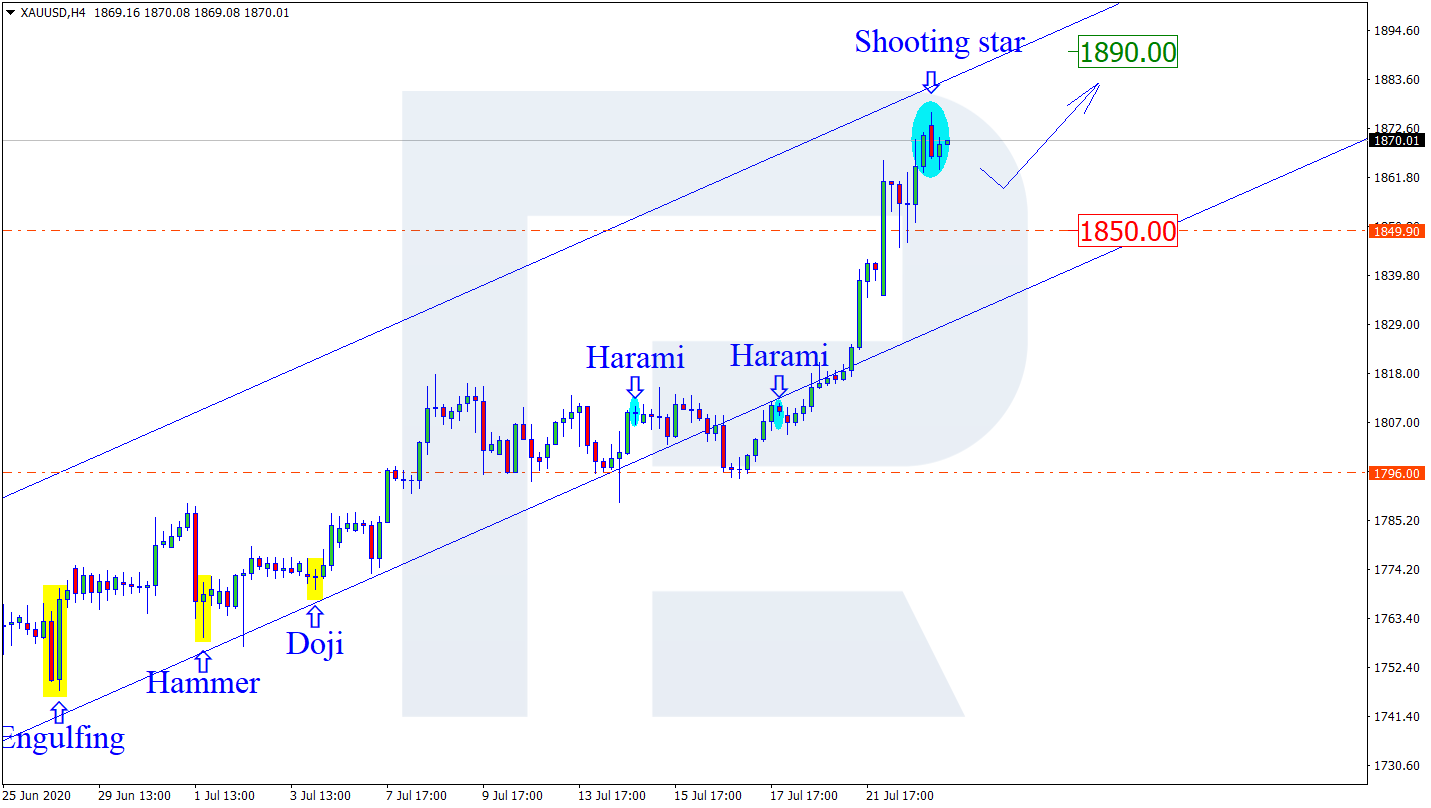

NZDUSD, “New Zealand vs. US Dollar”
As we can see in the H4 chart, the ascending tendency continues. After forming a Hanging Man pattern close to the channel’s upside border, NZDUSD has reversed and right now is updating its highs. Later, the market may continue growing to reach the next resistance level at 0.6725. Still, there is another scenario, which suggests that the instrument may correct towards the support area at 0.6650.
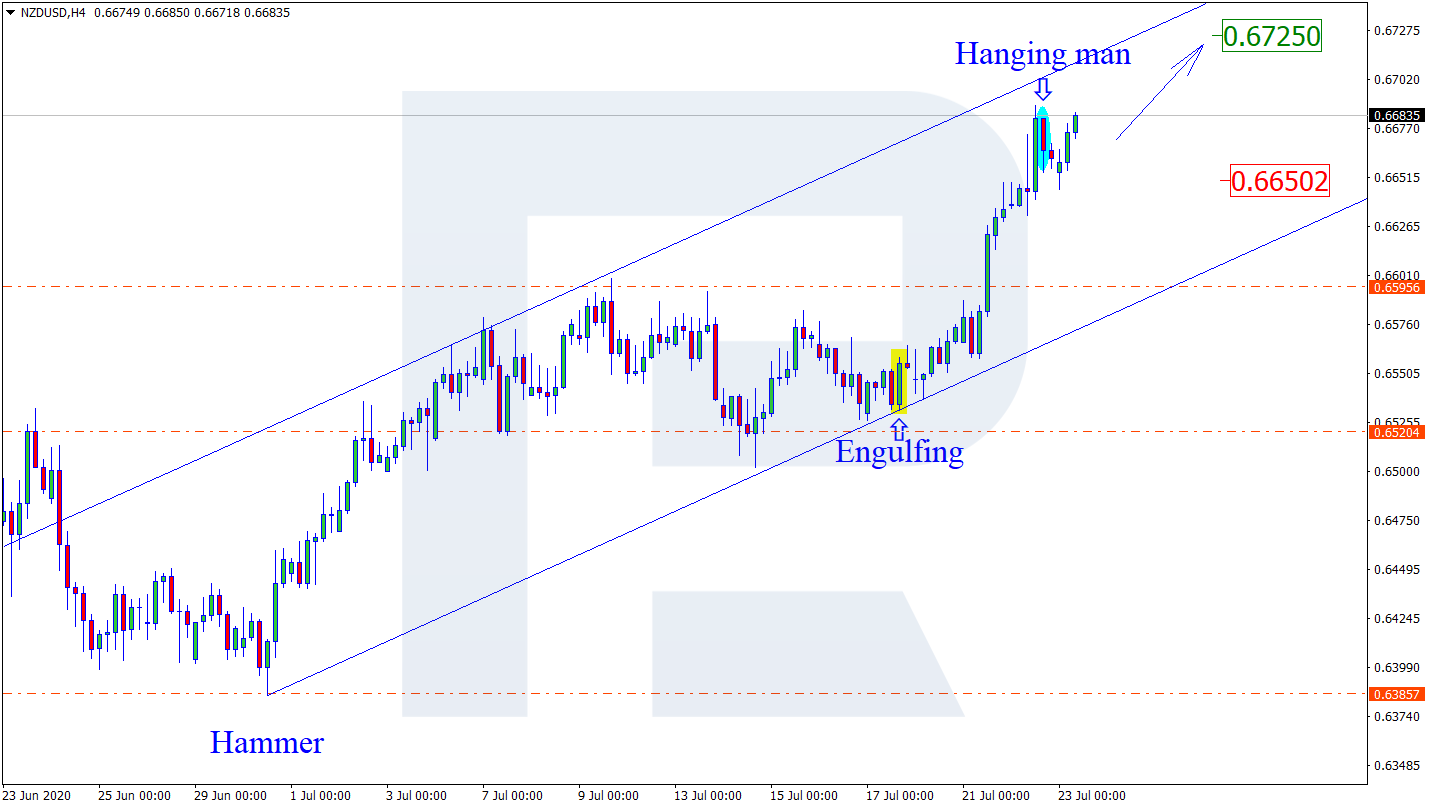

GBPUSD, “Great Britain Pound vs US Dollar”
As we can see in the H4 chart, the pair is still forming the ascending channel. After forming a Shooting Star pattern close to the resistance level, GBPUSD has reversed. At the moment, the price is expected to continue trading upwards. In this case, the upside target remains at 1.2800. However, there might be another scenario, according to which the price may fall to return to 1.2657.
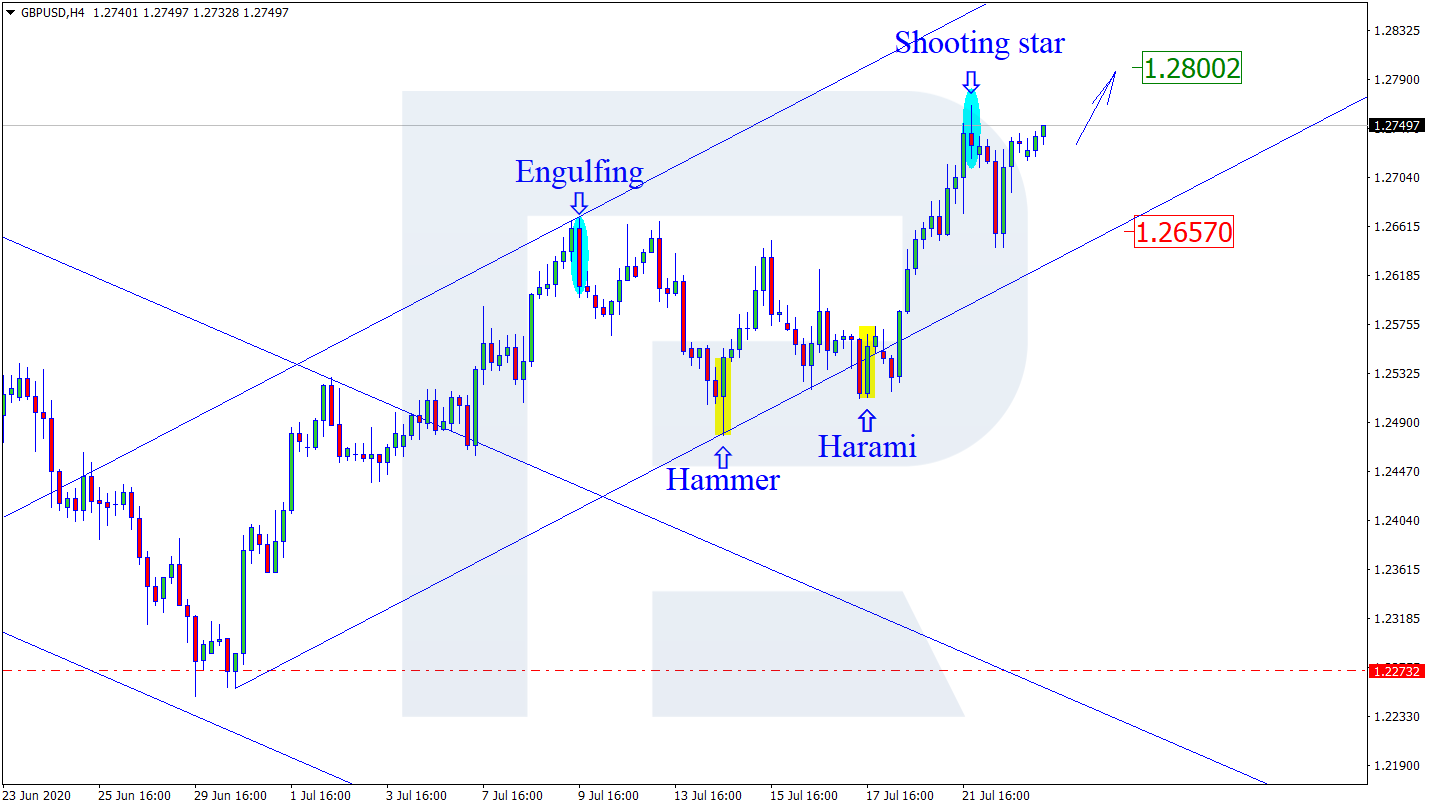
Article By RoboForex.com
Attention!
Forecasts presented in this section only reflect the author’s private opinion and should not be considered as guidance for trading. RoboForex LP bears no responsibility for trading results based on trading recommendations described in these analytical reviews.
– The move we saw in Silver early this week to new 6-year high price levels, above $22.60, is quite likely the biggest upside move in Silver since the bottom in March 2020 – after the US stock market collapsed because of the COVID-19 virus event. This new rally in Silver is likely the move we’ve been suggesting to our followers relating to a series of measured upside price moves totaling approximately $5.30 in each advance.
We wrote about these measured price moves in Gold and Silver in this article – Click Here
As traders, watching bonds accelerate moderately higher as the US Dollar falls and the stock market attempts new lofty levels, we are intrigued by the move in metals because it suggests a large segment of investors believe a bubble is nearing very peak valuation levels. The only reason metals, particularly Silver, would be accelerating as it has recently is that traders have suddenly adopted a stronger demand for second-stage hedging of risk.
Gold is the traditional hedge for many traders in times of risk. Silver, being the second-tier hedge, typically start to rally 4 to 6+ months after Gold begins to move substantially higher. Gold is currently trading near all-time highs – near $1820. Silver just recently bottomed in March 2020 near $11.65 and has rallied more than 70% to current levels – above $20.35. If our research is correct, Silver will rally to levels above $26 within this current upside rally.
The multiple measured moves in Gold and Silver suggest waves of price advances happen in a series of structured upside price moves. We believe this current upside move in Silver will push price levels above $26 per ounce. If Gold continues to rally as Silver rallies, then future measured moves should target $31.50 and $36.75 in Silver – possibly higher.
I recently talked about silver specifically in both of these videos. The detail of what to expect and timing of the breakout is explained in layman terms and both short term traders and long term investors will benefit. No matter if you like miner stocks or if you buy physical metals, there are two videos you should watch/listen to.
The Gold to Silver ratio is currently at 89.1. It peaked in March 2020 at 126.6. Historically, after a peak in this ratio is established at a time when the global stock market enters a period of contraction or extreme risk. From the peak in the Gold to Silver ration in late 2008, the ratio contracted over 63% to bottom in mid-2011. That bottom in the ratio was very close to the peak in Gold and Silver price levels.
Before you continue, be sure to opt-in to our free market trend signals
before closing this page, so you don’t miss our next special report!
If a similar type of price decline happens in the Gold to Silver ratio, it should fall to levels near 47.5 from the current level near 90. This represents a substantial drop in the ratio level – which translates into a continued rally in both Gold and Silver until a peak syncing of price between Gold and Silver is reached. Once the Gold to Silver ratio contracts below 60, it is likely that both Gold and Silver will begin to rally in similar price ranges. That will be a very exciting time to watch for gold and silver bugs because both Gold and Silver could rally 8% to 15% each week (or more).
Once Gold reached the $1950 level, the next measured move target, subsequent target levels are $2200, then $2450. Remember, traders, move into metals to hedge against risks they perceive in the stock, credit markets, and global economy. At this point, we have to believe traders are pumping capital in Silver as Gold nears recent all-time highs. We can’t ignore the fact that traders are actively hedging unknown risks in the markets aggressively in metals.
In fact, if you consider what the US Fed, global central banks and governments have attempted to accomplish over the past 6+ months and what has happened in Gold and Silver over the past 3+ years, it suggests traders have been actively hedging against market risks for over 2+ years. They are more aggressively hedging right now – which suggests there is a very strong fear that the markets are trading on borrowed-time near these current high price levels.
Our passive investor signal newsletter which tells you when to own stocks, bonds, and metals has been long gold since it started a new bull market of July 2019. We have since added large-cap gold miners which have also started a bull market this year. Silver, well it’s just getting started, better late, than never!
We’ve continued to urge traders to stay cautious over the past 12+ months because of the risks identified by our proprietary modeling systems and our super-cycle research. Right now, we believe the risks of a major contraction in the US and global markets are still rather high. The new highs in the NASDAQ are evidence of a DOT COM-like disconnect in the markets. The US stock market is not rallying in a healthy manner – certain segments are rallying because they are still generating profits while the COVID-19 virus blows holes throughout the global economy.
Pay attention to what is happening in Gold and Silver because they are screaming “risk is excessive throughout the world” and traders that are chasing the rally in the US stock market could wake up to a very sudden surprise soon.
Get our Active ETF Swing Trade Signals or if you have any type of retirement account and are looking for signals when to own equities, bonds, or cash, be sure to become a member of my Passive Long-Term ETF Investing Signals which we are about to issue a new signal for subscribers.
Chris Vermeulen
Chief Market Strategies
Founder of Technical Traders Ltd.
NOTICE: Our free research does not constitute a trade recommendation or solicitation for our readers to take any action regarding this research. It is provided for educational purposes only. Our research team produces these research articles to share information with our followers/readers in an effort to try to keep you well informed.
by JustForex
The EUR/USD currency pair
- Prev Open: 1.15281
- Open: 1.15687
- % chg. over the last day: +0.37
- Day’s range: 1.15642 – 1.15983
- 52 wk range: 1.0777 – 1.1494
The US dollar continues to lose ground against a basket of world currencies. EUR/USD quotes have reached the round level of 1.1600. The 1.1545 mark is already a “mirror” support. Relations between Washington and China have escalated again. The US ordered to close the Chinese consulate in Houston. A weak report on existing home sales in the US put additional pressure on the American currency. The demand for greenback is still low. Nevertheless, a technical correction is possible in the near future. We recommend opening positions from key levels.
- – Initial jobless claims in the US at 15:30 (GMT+3:00).

Indicators signal the power of buyers: the price has fixed above 50 MA and 100 MA.
The MACD histogram is in the positive zone, but below the signal line, which gives a weak signal to buy EUR/USD.
Stochastic Oscillator is in the neutral zone, the %K line is below the %D line, which indicates the bearish sentiment.
- Support levels: 1.1545, 1.1500, 1.1460
- Resistance levels: 1.1600, 1.1650
If the price fixes above 1.1600, further growth in EUR/USD quotes is expected. The movement is tending to 1.1640-1.1660.
An alternative may be a decline in the EUR/USD currency pair to the round level of 1.1500.
The GBP/USD currency pair
- Prev Open: 1.27264
- Open: 1.27159
- % chg. over the last day: -0.02
- Day’s range: 1.26984 – 1.27539
- 52 wk range: 1.1466 – 1.3516
The GBP/USD currency pair has become stable. At the moment, the British pound is consolidating. Quotes are testing local support and resistance levels: 1.2700 and 1.2745, respectively. The technical pattern signals a possible correction of a trading instrument after a significant increase since the beginning of this week. We recommend paying attention to the news feed on the US economy. Positions should be opened from key levels.
The publication of important UK economic releases is not planned today.

Indicators do not give accurate signals: the price has crossed the 50 MA.
The MACD histogram is near the 0 mark.
Stochastic Oscillator is in the neutral zone, the %K line is below the %D line, which indicates the bearish sentiment.
- Support levels: 1.2700, 1.2660, 1.2635
- Resistance levels: 1.2745, 1.2765, 1.2800
If the price fixes below 1.2700, GBP/USD quotes are expected to correct. The movement is tending to 1.2660-1.2630.
An alternative could be the growth of the GBP/USD currency pair to 1.2780-1.2820.
The USD/CAD currency pair
- Prev Open: 1.34599
- Open: 1.34118
- % chg. over the last day: -0.31
- Day’s range: 1.33709 – 1.34196
- 52 wk range: 1.2949 – 1.4668
The USD/CAD currency pair shows a steady downtrend. The trading instrument has set new local lows. At the moment, USD/CAD quotes are testing the support of 1.3375. The 1.3425 mark is already a “mirror” resistance. The loonie has the potential for further growth against the greenback. We recommend paying attention to the dynamics of the “black gold” prices. Positions should be opened from key levels.
The news feed on Canada’s economy is calm.

Indicators signal the power of sellers: the price has fixed below 50 MA and 100 MA.
The MACD histogram is in the negative zone and below the signal line, which gives a strong signal to sell USD/CAD.
Stochastic Oscillator is in the oversold zone, the %K line has crossed the %D line. There are no signals at the moment.
- Support levels: 1.3375, 1.3340, 1.3300
- Resistance levels: 1.3425, 1.3460, 1.3480
If the price fixes below 1.3375, a further drop in USD/CAD quotes is expected. The movement is tending to 1.3340-1.3320.
An alternative could be a recovery of the USD/CAD currency pair to 1.3450-1.3480.
The USD/JPY currency pair
- Prev Open: 107.204
- Open: 107.115
- % chg. over the last day: +0.35
- Day’s range: 107.073 – 107.195
- 52 wk range: 101.19 – 112.41
The technical pattern on the USD/JPY currency pair is still ambiguous. There is no defined trend. Financial market participants expect additional drivers. At the moment, the following local support and resistance levels can be distinguished: 107.10 and 107.30, respectively. We recommend paying attention to the dynamics of US government bonds yield. Positions should be opened from key levels.
Today, Japan’s financial markets are closed due to the holiday.

Indicators do not give accurate signals: the price has crossed the 100 MA.
The MACD histogram is in the positive zone, but below the signal line, which gives a weak signal to buy USD/JPY.
Stochastic Oscillator is in the neutral zone, the %K line is above the %D line, which indicates the bullish sentiment.
- Support levels: 107.10, 106.90, 106.70
- Resistance levels: 107.30, 107.40, 107.60
If the price fixes above 107.30, USD/JPY quotes are expected to rise. The movement is tending to 107.50-107.70.
An alternative could be a decline in the USD/JPY currency pair to 106.90-106.70.
by JustForex
Our research team believes Crude Oil and Energy, in general, has stalled near major resistance and maybe setting up a big downside move as the COVID-19 virus continues to roil regional and global economies.
The recent news that the COVID-19 virus cases have skyrocketed suggests further economic shutdowns may push oil prices below $35 ppb over the next few weeks and months. Our researchers believe Oil has already set up a resistance level near $42 and will begin to move lower as concerns about the economic recovery transition through expectations related to oil demand going forward. We believe the renewed global economic demand for oil will present a very real possibility that oil could collapse below $35 ppb over the next 30 days.
We believe this pending downside move in Crude Oil will set up a great trade opportunity in ERY, the Direxion Bear Energy 2x ETF. At this point in time, we are just waiting for the technical confirmation of this trade trigger. Once we receive confirmation from our price modeling systems, we believe ERY may rally 20% to 30% or more from current levels.
Before you continue, be sure to opt-in to our free market trend signals
before closing this page, so you don’t miss our next special report!
Our research team believes Crude Oil’s inability to rally above $42 recently suggests strong resistance exists near the $42 level. There could be a short squeeze in price where oil pops to $44-45 and then reverses quickly below $41, which would be a great sell signal for falling oil.
We believe Q3 will present a very real opportunity for oil to fall below $35 ppb over the next few weeks. Possibly moving much lower – below $30 ppb. Once this move confirms, we’ll have the opportunity to jump into the ERY trade where we may attempt to capture 20% or more on a quick technical trade.
Our proprietary Fibonacci Price Modeling system is suggesting an initial upside price target for ERY near $68. This suggests a potential 35% upside price move in ERY is Crude Oil Collapses as we expect. This presents an excellent trading opportunity for skilled technical traders.
As we wait for Crude Oil to breakdown, traders should watch the GAP below $48 as a potential deep price support level in ERY. The upside potential profits for this trade is still rather substantial. We just need to wait for the proper technical confirmation for this setup because news or any geopolitical events could dramatically change expectations for Crude oil.
Get our Active ETF Swing Trade Signals or if you have any type of retirement account and are looking for signals when to own equities, bonds, or cash, be sure to become a member of my Passive Long-Term ETF Investing Signals which we are about to issue a new signal for subscribers.
Chris Vermeulen
Chief Market Strategies
Founder of Technical Traders Ltd.
NOTICE: Our free research does not constitute a trade recommendation or solicitation for our readers to take any action regarding this research. It is provided for educational purposes only. Our research team produces these research articles to share information with our followers/readers in an effort to try to keep you well informed.
By Felix Arndt, University of Guelph
Do-it-yourself (DIY) and at-home labs gained popularity through movies and TV shows like Breaking Bad. DIY labs are increasingly influential and may change lives — the OpenInsulin project, for example, is looking for DIY ways to produce insulin and reduce its price to US$7 from US$300. This impact will likely become even more prevalent in the new post-pandemic normal.
Innovation has moved from corporate research and development labs into the private kitchens, bathrooms and basements around the world. Innovators are not big names often affiliated to universities or think tanks, but may be your neighbour.
Informal experimentation
DIY labs today are not limited to biohacking and chemical applications anymore — they are found in many industries and have increasing impact. Examples include DIY labs for materials, maker spaces of all kinds, micro-electronics, hackerspaces and many more.
This surge of DIY labs has mainly two sources. One is digitalization. It is easy to find communities online and discuss expert topics with other specialists. Access and budgets become less of an issue in a world that easily connects via the internet.
The second source is accessible education and a revolution of workspace towards individual homes. Since the pandemic, garages and basements all over the world have become hobby rooms. Hobbies have diversified with significant amateur expertise. As such, everyone can be an inventor, hacker or entrepreneur today.
Craft breweries
One prominent example in which DIYers have shaped an industry is the re-emergence of micro and craft breweries. In the 2010s, the beer market experienced mergers and acquisitions. This peaked with the mega-merger of AB Inbev and SAB Miller to capture more than 80 per cent of the market in North and South America. Accordingly, beer shelves in supermarkets were full of brands from the same companies.
In the past few years however, we have seen a surge of craft beer. Brands like Brewdog (United Kingdom) or Goose Island (Chicago, Ill.) emerged from passionate homebrewers who eventually commercialized their homebrews. Craft beer does not make life easier for AB Inbev.
In Guelph, Ont., a small city with a population of approximately 135,000, there are at least five breweries and two distilleries. One of these, Sleeman, is owned by Sapporo, a larger player with headquarters in Japan. Most of the other brewers started as at-home DIY breweries, and subsequently started to commercialize and scale their homebrews.
This means that the large corporations that used to enjoy near-monopolies now fight increasing competition from numerous niche players. The setting of the beer industry is an excellent example to see how frustration with existing products, combined with a passion for experimentation, can spur new innovations that can have implications for the industry.
New product innovations in the beer industry often emerge from acquiring smaller players and adopting their products, thus expanding the product portfolio. Plenty of smaller breweries in Canada have have been acquired by larger corporations, such as the Granville Island Brewing Company (acquired by Molson Coors in 2009), Hop City Brewing Co. (a subsidiary of Moosehead Breweries) or Unibroue (acquired by Sleeman in 2004), to name just a few.
Post-pandemic experimentation
The pandemic has triggered the realization that our homes are places where we spend much time and that may be part of our self-realization.
For many people, this means today to experiment with ideas they have. The emergence of DIY labs in homes is facilitated by this trend. Craft brewers have shown the way; other industries may be about to be disrupted.
Many megatrends from digitalization to automation have been accelerated by the pandemic. For example, many brick and mortar shops are now online, and much of the discussion about Canadian food security includes revolutionizing farming with more automatization. We will likely see a surge of people moving outside the densely populated cities if they have the luxury to work from home.
This means that there will be more space to experiment, play, learn, innovate and possibly change the way things have been done.![]()
About the Author:
Felix Arndt, John F. Wood Chair in Entrepreneurship, University of Guelph
This article is republished from The Conversation under a Creative Commons license. Read the original article.
By Orbex
Dollar Struggles Across the Board
The dollar realized further declines on Tuesday as the index closed 0.58% lower. The coronavirus situation in the US is taking a further toll as cases arise. President Trump stated that the outbreak is likely to worsen.
Further struggles to reach a consensus on the next round of economic stimulus measures drag on. This weakened the dollar to deeper territories as investors turned to riskier assets.
Euro Rejuvenated After EU Agreement
The euro traded at its highest level in more than a year in the morning session, breaking above 1.15. This comes as European leaders struck an agreement for a €750bn pandemic recovery fund.
Progress towards a coronavirus vaccine also weighed on the US dollar. This came as European biopharma companies reported encouraging trial results.
Pound Bullish But Brexit Uncertainty Looms
The pound kept its momentum against the weakened US dollar, closing 0.54% higher on Tuesday. GBPUSD recorded highs above the 1.27 handle.
This morning, cable is slightly down against the dollar amid reports of a no-deal Brexit. UK ministers have expressed skepticism over the current Brexit negotiations.
In addition, government officials recently abandoned hopes of reaching a US-UK trade deal by November.
Asia-Pacific Buoyed Over Weakened Greenback
Asian stocks ended mixed on Tuesday. While investors praised the EU’s stimulus plan, rising infection numbers dented optimism.
The yen closed 0.40% over the dollar on Tuesday, indicating a further push towards the safe-haven asset.
Aussie crossed over 0.71, closing the highest since April last year. The neighboring Kiwi also edged up above 0.66, advancing to its highest level in 2020.
Mixed Bag for US Stocks
The S&P increased for a third consecutive day, led by gains in the energy and financial sectors.
The technology sector lost momentum, however, leading Nasdaq 0.8% lower.
Investors are awaiting earnings reports from Tesla and Microsoft later today. This could see the index recovering yesterday’s losses.
Further Breakthrough for the Yellow Metal
Gold reached another milestone overnight, rising above $1860. This move was urged on by Trump’s comments that the coronavirus will ‘get worse before it gets better’.
Furthermore, US officials debate over the renewal of the expiration of the unemployment benefits. The next stimulus bill, however, must be agreed upon before the end of July.
Crude Traders Eye EIA Following Poor API
Oil prices rose over $42 in yesterday’s trading. However, crude retracted many of its gains by the end of the day.
Weak API figures left oil prices on a precarious footing. With investors assessing the impact on demand from the increasing US virus figures, prices could remain mixed for the short-term.
By Orbex
Risk Disclosure: Foreign Currency trading and trading on margin carries a high level of risk and can result in loss of part or all of your investment. Due to the level of risk and market volatility, Foreign Currency trading may not be suitable for all investors and you should not invest money you cannot afford to lose. Before deciding to invest in the foreign currency exchange market you should carefully consider your investment objectives, level of experience, and risk appetite. You should be aware of all the risks associated with foreign currency exchange trading, and seek advice from an independent financial advisor should you have any doubts.
All information and opinions on this website are for general informational purposes only and do not constitute investment advice.
